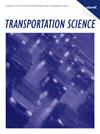设施选址问题:利用从属关系建立联合干扰模型
IF 4.8
2区 工程技术
Q1 OPERATIONS RESEARCH & MANAGEMENT SCIENCE
引用次数: 0
摘要
我们研究的是存在中断情况下的设施选址问题,其目标是选择一组地点,使预期服务和设置成本之和最小。中断会同时影响多个地点,并由地理、供应链特征、政治和所有权等多种因素造成。由于需要大量的参数、缺乏校准方法、中断数据稀少以及优化中需要考虑的情况较多,在建立中断模型时考虑各种因素具有挑战性。由于这些原因,现有模型忽略了依赖性或预先规定了依赖性结构。通过使用部分从属马尔可夫链,我们提出了一种综合方法,该方法从干扰数据出发,建立依赖关系模型,校准干扰模型,并优化位置选择。我们构建了一种度量和校准算法,可从数据中了解依赖性的强度、必要因素(从属因素)的数量以及每个从属因素影响的位置。我们证明,我们的校准方法可以得到一致的模型参数估计。然后,我们引入了一种标准方法的变体,利用部分从属马尔可夫链快速、精确地解决基础优化问题。最后,我们利用 12 个不同的干扰数据集证明了我们方法的有效性。我们的校准参数是稳健的,我们的优化算法比基于模拟的算法表现更好。与其他干扰模型相比,我们的干扰模型解决方案成本更低。我们的方法可以从历史数据中更好地建立中断模型,并可适用于物流中的其他问题,如枢纽位置、容纳设施位置等,以及联合中断问题:在线附录见 https://doi.org/10.1287/trsc.2023.0103 。本文章由计算机程序翻译,如有差异,请以英文原文为准。
Facility Location Problem: Modeling Joint Disruptions Using Subordination
We study the facility location problem with disruptions where the objective is to choose a set of locations that minimizes the sum of expected servicing and setup costs. Disruptions can affect multiple locations simultaneously and are caused by multiple factors like geography, supply chain characteristics, politics, and ownership. Accounting for the various factors when modeling disruptions is challenging due to a large number of required parameters, the lack of calibration methodologies, the sparsity of disruption data, and the number of scenarios to be considered in the optimization. Because of these reasons, existing models neglect dependence or prespecify the dependence structures. Using partially subordinated Markov chains, we present a comprehensive approach that starts from disruption data, models dependencies, calibrates the disruption model, and optimizes location choices. We construct a metric and a calibration algorithm that learns from the data the strength of dependence, the number of necessary factors (subordinators), and the locations each subordinator affects. We prove that our calibration approach yields consistent estimates of the model parameters. Then, we introduce a variant of the standard approach to the underlying optimization problem, which leverages partially subordinated Markov chains to solve it quickly and precisely. Finally, we demonstrate the efficacy of our approach using twelve different disruption data sets. Our calibrated parameters are robust, and our optimization algorithm performs better than the simulation-based algorithm. The solutions from our model for disruptions have lower costs than those from other disruption models. Our approach allows for better modeling of disruptions from historical data and can be adapted to other problems in logistics, like the hub location, capacitated facility location, and so on., with joint disruptions.Supplemental Material: The online appendix is available at https://doi.org/10.1287/trsc.2023.0103 .
求助全文
通过发布文献求助,成功后即可免费获取论文全文。
去求助
来源期刊

Transportation Science
工程技术-运筹学与管理科学
CiteScore
8.30
自引率
10.90%
发文量
111
审稿时长
12 months
期刊介绍:
Transportation Science, published quarterly by INFORMS, is the flagship journal of the Transportation Science and Logistics Society of INFORMS. As the foremost scientific journal in the cross-disciplinary operational research field of transportation analysis, Transportation Science publishes high-quality original contributions and surveys on phenomena associated with all modes of transportation, present and prospective, including mainly all levels of planning, design, economic, operational, and social aspects. Transportation Science focuses primarily on fundamental theories, coupled with observational and experimental studies of transportation and logistics phenomena and processes, mathematical models, advanced methodologies and novel applications in transportation and logistics systems analysis, planning and design. The journal covers a broad range of topics that include vehicular and human traffic flow theories, models and their application to traffic operations and management, strategic, tactical, and operational planning of transportation and logistics systems; performance analysis methods and system design and optimization; theories and analysis methods for network and spatial activity interaction, equilibrium and dynamics; economics of transportation system supply and evaluation; methodologies for analysis of transportation user behavior and the demand for transportation and logistics services.
Transportation Science is international in scope, with editors from nations around the globe. The editorial board reflects the diverse interdisciplinary interests of the transportation science and logistics community, with members that hold primary affiliations in engineering (civil, industrial, and aeronautical), physics, economics, applied mathematics, and business.
 求助内容:
求助内容: 应助结果提醒方式:
应助结果提醒方式:


